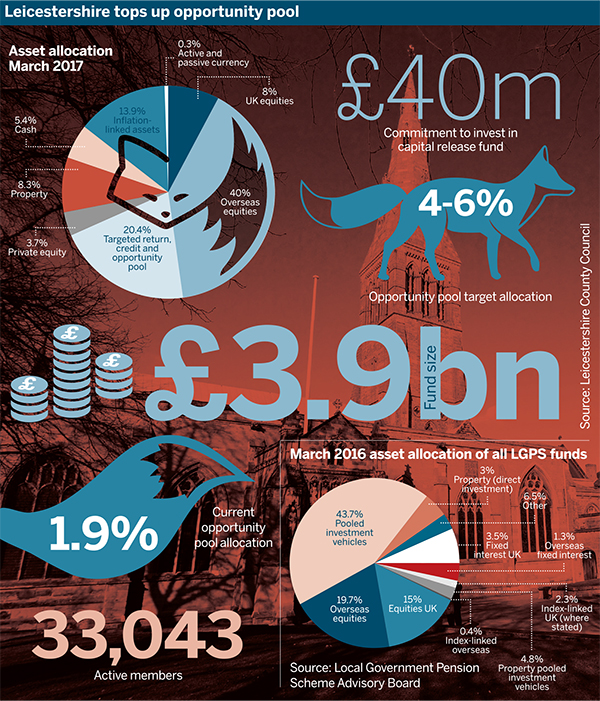Leicestershire County Council Pension Fund has committed to a new capital release fund investment as part of its growing opportunity pool allocation, as banks look to free up capital.
A bank has to hold more regulatory capital if it wants to increase its lending activity. This can be costly, but banks can arrange to shift the risk of loans made to free up capital to support further lending activities. Banks can afford to pay a healthy premium to the counterparty that the risk is being transferred to, Leicestershire County Council’s investment subcommittee heard in June.
If you fill your boots quickly, and are not discerning in terms of what opportunities you think are attractive, then you'll quickly run out of capital
Colin Pratt, Leicestershire County Council
The subcommittee has agreed to a £40m investment, making up around 1 per cent of the £3.9bn pension scheme’s total portfolio. The fund, which is managed by Christofferson, Robb & Company, buys portfolios of loans from banks and is paid an insurance premium by the banks to do this.
Colin Pratt, investment manager, said the decision to invest was made because the fund looks to be “an attractive opportunity to get attractive risk-adjusted returns”.
It will sit in the scheme’s opportunity pool, which is designed to include investments that are expected to produce returns at least as high as those expected from equities, as well as providing diversification.
Schemes advised to be selective
Pratt said the main purpose of the pool is “to invest in things that look to be attractive investment opportunities but don’t necessarily fit in easily with the rest of the fund’s asset allocation strategy”, because they may be relatively niche, for example.
This opportunity pool has a target allocation of 4-6 per cent of the scheme’s assets, but currently only 1.9 per cent of the available pool funding is invested. Within the next 12 to 18 months, around 3 per cent of the scheme’s total assets will be invested in the pool due to other investments, which are currently undrawn.

Pratt said that the 4 per cent minimum target is in place to set the objective of getting appropriate investments into the pool, provided they are attractive opportunities.
“It could theoretically be 0-6 [per cent], it could be 2-6 [per cent]… but the 4 [per cent] just sets the objective fairly clearly that that is actually what we’re trying to do,” he said.
“If you fill your boots quickly, and are not discerning in terms of what opportunities you think are attractive, then [you’ll] quickly run out of capital, because you can only afford a certain amount of capital in these kinds of funds for the long term,” he added.
The subcommittee has acknowledged that the capital release fund “is clearly not risk-free” but argued that the manager has a long track record of avoiding meaningful defaults.
Banks incentivised to offload more risk
The scheme’s investment is being made at the same time as the Bank of England is attempting to make lenders more resilient to the risk of increasing consumer debt, and it has recently informed UK banks that it would raise the “countercyclical capital buffer” requirement to 0.5 per cent from 0 per cent.
MPs’ scheme votes for secured loans over REITs
The Parliamentary Contributory Pension Fund has simplified its property portfolio and invested proceeds in a European loans mandate, with a view to generating income.
“This will provide a buffer of capital that can be released quickly in the event of an adverse shock occurring that threatens to tighten lending conditions,” it explained.
James King, asset-backed securities fund manager at M&G Investments, said the move “won’t have a direct impact” on investing in regulatory capital release funds, but it may “make it more likely that the banks are incentivised to look to reduce their capital requirements by offloading more of this type of risk”.
King said that, in general, investing in capital release funds “works for the investor if the bank can demonstrate that historically it’s a very low-risk portfolio with a low default experience and that there is sufficient reason to believe that that will continue to be the case”.
James Trask, partner at investment consultancy LCP, noted that “the expected yield on this type of investment varies quite a lot according to the appetite of the bank” to offload the risk. He added that it is more suited to a large scheme with a big governance budget, partly due to its complexity.
The idea of keeping an opportunity pool “is a good one”, said Trask. “The difficulty right now is that a lot of what might be deemed to be the best opportunities are probably all fairly correlated to each other.”














